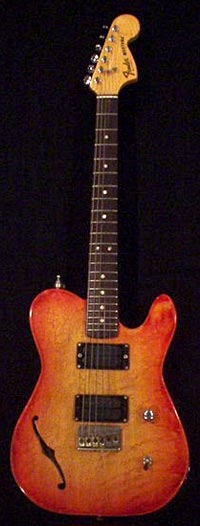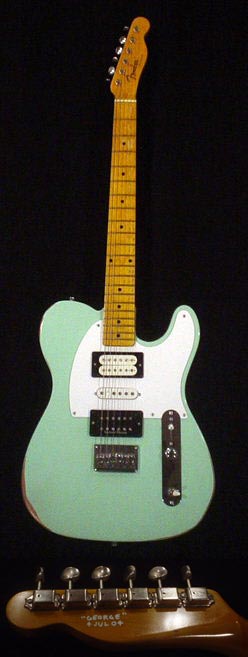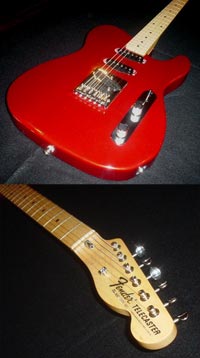 A bit about myself: I am an attorney in Houston, Texas, and a die-hard Texas Longhorn (BBA 1987, JD 1991, MBA 1992). My
inspiration for building guitars goes back to Eddie Van Halen, circa 1981. It blew me away to think that - with no real experience - EVH could build such good-looking and
cool-sounding guitars. I made my first guitar body around age 16 - a one-piece Honduran mahogany Explorer-type guitar with a Fender Mustang neck. Talk about a freak of nature! But
it played and sounded so nice that it became my No. 1 axe for years. And from there I was hooked. A bit about myself: I am an attorney in Houston, Texas, and a die-hard Texas Longhorn (BBA 1987, JD 1991, MBA 1992). My
inspiration for building guitars goes back to Eddie Van Halen, circa 1981. It blew me away to think that - with no real experience - EVH could build such good-looking and
cool-sounding guitars. I made my first guitar body around age 16 - a one-piece Honduran mahogany Explorer-type guitar with a Fender Mustang neck. Talk about a freak of nature! But
it played and sounded so nice that it became my No. 1 axe for years. And from there I was hooked.I don't really know what happened to that Explorer body,
but the neck now resides on one of my home-built Teles. 1. Sunburst hollowbody with a Mustang neck
First is a hollowbody I made while serving in the U.S. Air
Force in the mid 1990s. I loved the military, and one of the best parts was that they had these "wood hobby shops," fully loaded with all the tools you could
ever want. I had a spare Mustang neck laying around, so (naturally) I freehanded a Tele-style body, scaled down to match the Mustang's 24-inch scale. Actually, I think I scaled it
down a little too much, but it still looks good. This was my first (and only) hollow body, and my first sunburst. The top is a single piece of birdseye maple; the back is a single slab of hard
maple, routed out beyond all comprehension. There are lots of flaws, and the guitar looks much better than it plays. Still, it was a very ambitious project at that time in my life, and I'm
proud to have done it.  2. Surf Green Tele-Gib/Strat Hybrid ("George") 2. Surf Green Tele-Gib/Strat Hybrid ("George")
Second is a two-piece alder Tele that was to
serve two purposes: (1) to be versatile (able to approximate Gibson and Fender sounds); and (2) to test my budgeting skills. I bought the slab and crafted the body therefrom. I bought a
no-name paddle-head neck, shaped the head, and applied a Fender decal. I painted it ReRanch surf green from a can, cleared it with nitro, and relic'd the crap out of it. It played its
first tune on July 4, 2004 -- the Star-Spangled Banner, of course. One of the best-sounding guitars I've ever owned. It has a 5-way Strat switch (pickup combinations are B, B+M, M, M+N, N). That
extra toggle switch where the tone knob usually is functions as a coil tap: in the "up" position, both double-coils are in two-coil mode; in the middle, the neck pickup is
tapped (and functions as a single-coil); and in the down positions, all three pickups function as single-coils, essentially giving the configuration of a Strat. This Tele is dedicated to my
grandfather (George), who died a couple of weeks after I finished this guitar. He taught me about woodworking when I was a kid, and helped me build my first guitar body at age 16.
3. My (Lucky) Son's Tele With My First Homemade Neck
I built this next one for my son's tenth birthday. The kid has really impressed me with his (downright amazing) piano playing
and his keen interest in learning guitar. He even likes the music I crave -- Led Zeppelin, Van Halen, all the classic rock stuff that kids his age don't  even recognize anymore! Eager to reward his
behavior, I decided to build him a guitar. Yeah, I could have bought him one, but I wanted this to be extremely special and wanted to give him an heirloom. But I also wanted to throw a
twist into it: I wanted him to help me design it -- but without knowing it would be his! So we drew up a prototype, he picked a color, and we discussed woods. I took him down to the
lumber yard, where he helped me pick out some nice heavy ash and some hard maple for the neck. He helped me build it here and there, and while he was incapable of doing a whole lot,
he felt involved. I put a Fender Tele decal on the headstock, but in tiny letters it bears the inscription "Custom made in the U.S.A. for [his name]." I also
took this opportunity to make my very first neck. Again, I was ambitious, going with a one-piece maple neck with a skunk stripe down the back. A bit more complicated than a two-piece
neck, but with care, I was able to pull it off. I gave it a Stevie-Ray-Vaughn-style asymmetrical profile on the rear, along with a satin finish, for playability. I painted the body with
DupliColor acrylic lacquer, with about a million clear coats. That bridge pickup is a GFS Lil Puncher; the others are regular GFS Strat pickups. The tone control uses a push-pull pot that taps
one of the two neck-pickup coils. The switch is a Strat five-position switch (again, B, B+M, M, M+N, N). even recognize anymore! Eager to reward his
behavior, I decided to build him a guitar. Yeah, I could have bought him one, but I wanted this to be extremely special and wanted to give him an heirloom. But I also wanted to throw a
twist into it: I wanted him to help me design it -- but without knowing it would be his! So we drew up a prototype, he picked a color, and we discussed woods. I took him down to the
lumber yard, where he helped me pick out some nice heavy ash and some hard maple for the neck. He helped me build it here and there, and while he was incapable of doing a whole lot,
he felt involved. I put a Fender Tele decal on the headstock, but in tiny letters it bears the inscription "Custom made in the U.S.A. for [his name]." I also
took this opportunity to make my very first neck. Again, I was ambitious, going with a one-piece maple neck with a skunk stripe down the back. A bit more complicated than a two-piece
neck, but with care, I was able to pull it off. I gave it a Stevie-Ray-Vaughn-style asymmetrical profile on the rear, along with a satin finish, for playability. I painted the body with
DupliColor acrylic lacquer, with about a million clear coats. That bridge pickup is a GFS Lil Puncher; the others are regular GFS Strat pickups. The tone control uses a push-pull pot that taps
one of the two neck-pickup coils. The switch is a Strat five-position switch (again, B, B+M, M, M+N, N). The boy loves it, and nearly passed out when I presented it to
him in front of the family. He designed it, and now it's his.
|

